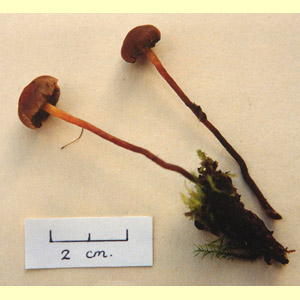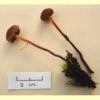
images/Hypholoma_section_Psilocyboides/Psilocybe_paludicolum_-__YS_Chang_photo.jpg
Small agaric, growing among bryophytes or on the ground or on litter or mulch, with a purple-brown or dark brown spore print. Pileus yellow-brown or orange-brown, not or rarely viscid. Lamellae adnate or subdecurrent. Stipe central. Partial veil remnants a ring zone or absent. Spores yellow-brown, brown or greyish (with reddish inner wall line in KOH), smooth; germ pore absent or narrow. Cheilocystidia present. Chrysocystidia present. Lamellar trama regular. Pileipellis a cutis; hypoderm subcellular. Clamp connections present.
Members of
Hypholoma section
Psilocyboides differ from other species of the genus by the solitary (rather than caespitose) fruit-bodies. They also differ by not growing on wood, but rather occur among moss (often
Sphagnum in alpine areas) or on the ground or on litter or mulch (and then forming a sclerotium). Other agarics with purple-brown spore print and smooth spores include
Psilocybe (with the pileus often viscid and lacking chrysocystidia) and
Stropharia (pileus usually viscid to glutinous and the hypoderm not cellular).
Pholiota shares the chrysocystidia of
Hypholoma section
Psilocyboides and can have a cellular hypoderm, and occasionally grows in
Sphagnum, but the spore print is ochre, clay or dark brown rather than purple-brown and the pileus is viscid or glutinous.
Galerina is common in moss, and can be found in alpine areas, but it typically has an ochre-brown spore print and the spores are usually warty and with a plage, and the hypoderm is never cellular.
Hypholoma section
Psilocyboides (Singer) [Combination not yet made, based on
Naematoloma section
Psilocyboides Singer,
Sydowia 2: 36 (1948).].
A few species: a group allied to
Hypholoma elongatum [including
Hypholoma sp. (=
Psilocybe paludicola)] and
H. tuberosum (with sclerotium). This section is poorly known in Australia at present.
N.S.W. and Tas. (and probably also Vic.).
In native forests, especially alpine areas.
Among moss, especially Sphagnum or on the ground or on litter or mulch.
Saprotrophic.
Breitenbach, J. & Kränzlin, F. (eds) (1995),
Fungi of Switzerland.
Volume 4. Agarics 2nd part. Edition Mykologia, Lucerne. [
Illustration,
Description and
Microcharacters of
H. elongatum from Switzerland]
Chang, Y.S., Gates, G.M. & Ratkowsky, D.A. (2006), Some new species of the Strophariaceae (Agaricales) in Tasmania, Australas. Mycol. 24: 53–68. [B&W Illustration, Description and Microcharacters of Psilocybe paludicola, suggesting that it belongs in Psilocybe section Psilocyboides [which we place under Hypholoma]]
Priest, M.J. & Simpson, J.A. (1992), Hypholoma tuberosum in Australia, Mycologist 6: 11–12. [Illustration of H. tuberosum]
Redhead, S.A. & Kroeger, P. (1987), A sclerotium-producing Hypholoma from British Columbia, Mycotaxon 29: 457–465. [Description, B&W Illustration and Microcharacters of H. tuberosum]
Wood, A.E. (2003), Some agarics of the Kosciuszko National Park, Australas. Mycol. 22: 39–43. [Description and Microcharacters of H. aff. elongatum]


